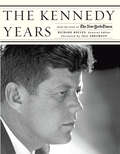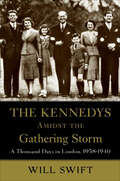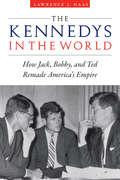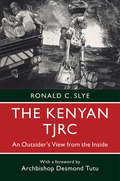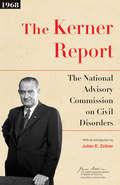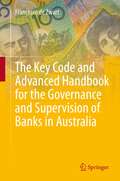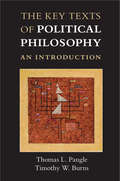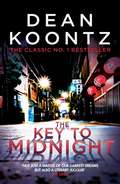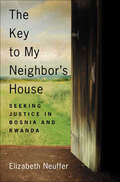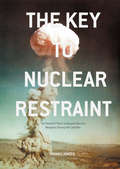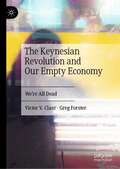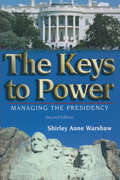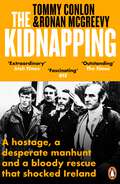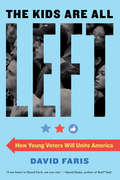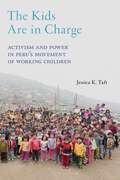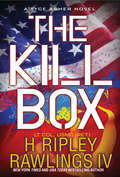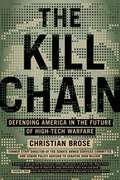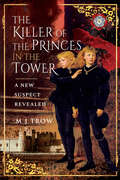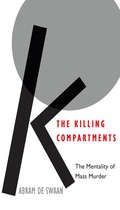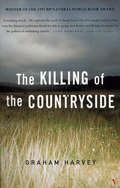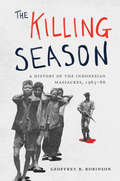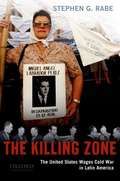- Table View
- List View
The Kennedy Years: From the Pages of The New York Times
by Jill Abramson“A deeply illuminating, journalistic romp through Camelot from the eyes and minds of the great New York Times reporters of that era and beyond.” —Douglas Brinkley, #1 New York Times–bestselling authorDecades after the assassination of John F. Kennedy, he still ranks as one of the top five presidents in every major annual survey. To commemorate the man and his time in office, the New York Times has authorized a book, edited by Richard Reeves, based on its unsurpassed coverage of the tumultuous Kennedy era. The Civil Rights Movement, the Bay of Pigs, the Cuban Missile Crisis, Vietnam, the space program, the Berlin Wall—all are covered in articles by the era’s top reporters, among them David Halberstam, Russell Baker, and James Reston. Also included are new essays by leading historians such as Robert Dallek and Terry Golway, and by Times journalists, including Sam Tanenhaus, Scott Shane, Alessandra Stanley, and Roger Cohen. With more than 125 color and black-and-white photos, this is the ultimate volume on one of history’s most fascinating figures.“This book is both fascinating and poignant. It brings us back into the Kennedy years while also allowing us to reflect on what made them so emotional. I found myself totally immersed.” —Walter Isaacson, #1 New York Times–bestselling author“Provides much more than a riveting first draft of history. Here we also witness the birth of modern America.” —Cokie Roberts, former political commentator and #1 New York Times–bestselling author “A terrific introduction to the Kennedy presidency for those who did not live through it, and a startling reminder for those who did of how much happened in those 1,000 days.” —David Nasaw, New York Times–bestselling author
The Kennedys Amidst the Gathering Storm: A Thousand Days in London, 1938–1940
by Will SwiftAmbassador Kennedy’s tenure during the approach of WWII is explored in “an admirably balanced assessment of an enormously complicated man” (Kirkus, starred review).In The Kennedys Amidst the Gathering Storm, historian and psychologist Dr. Will Swift presents a fresh, empathetic interpretation of Joseph Kennedy’s ambassadorship. With extensive research and penetrating psychological insight, he explores the intricate, often shifting relationships among Kennedy, Chamberlain, Churchill, and, of course, Roosevelt.Arriving in London in early 1938, the Irish-Catholic Kennedys were welcomed by politicians, aristocrats, and intellectuals, all eager to court America. They finally appeared to have overcome their lifelong status as outsiders. From 1938 to 1940, the Kennedys crystallized their identity as protagonists on the world stage, undergoing a near-mythic rise to power. The older children—Joe Jr., Jack, and Kathleen—took part in England’s glittering society, their every move chronicled by the British and American media. As Joe, Sr.’s, political fortunes dimmed, Jack published a best-selling book that launched him toward stardom and, ultimately, the White House.Drawing on recently released Kennedy family archives, Joseph P. Kennedy’s private papers, and using rare photographs of English society and the photogenic Kennedy clan, Dr. Swift brings to life this fascinating family during a dramatic thousand-day period.
The Kennedys in the World: How Jack, Bobby, and Ted Remade America's Empire
by Lawrence J. HaasThe Kennedys in the World tells a new, rich, fascinating, and consequential story about Jack, Bobby, and Ted Kennedy. From an early age the brothers developed a deep understanding of the different peoples, cultures, and ideologies around the world; a keen appreciation for the challenges that such differences created for the United States; and a strong desire to reshape America&’s response to them. From their childhoods in the first half of the twentieth century, the brothers were prodded by their ruthless, demanding, win-at-all-costs father, Joe Kennedy, and their cold and distant mother, Rose, to learn and care about the world—and told they could shape America&’s role in it. For more than six decades after World War II, the brothers shaped broad issues of war and peace as well as the U.S. response to almost every major global challenge of their times: the Soviet Union and China, the Cold War and Cuba, the Dominican Republic and Chile, Nicaragua and El Salvador, Korea and Vietnam, South Africa and Northern Ireland, and Iraq (twice). In their time, America was what it remains today—the world&’s greatest power, with roles and responsibilities that stretch across the planet. Consequently, as the brothers remade America&’s empire, they invariably changed the world.
The Kenyan TJRC: An Outsider's View from the Inside
by Desmond Tutu Ronald C. SlyeBetween 1963 and 2008 Kenya experienced systematic atrocities, economic crimes, ethnic violence, and the illegal taking of land. To come to terms with these historical injustices and gross violations of human rights, the Kenyan Truth, Justice and Reconciliation Commission (TJRC) was established. From the perspective of an insider and academic expert, The Kenyan TJRC: An Outsider's View from the Inside reveals for the first time the debates and decisions made within the Commission, including how the Kenyan Commission became the first such commission to recommend that its Chair be prosecuted for gross violations of human rights. This book is one of the few insider accounts of a truth commission, and one of the few that reflects on the limitations and opportunities of such a commission. The Kenyan TJRC provides lessons and recommendations to those interested in addressing historical injustices through a truth commission process. The full copy of the Final Report of the Kenyan TJRC, along with other supporting documents, can be found at the following site: https://digitalcommons.law.seattleu.edu/tjrc/
The Kerner Report
by Julian E. Zelizer The National Advisory Commission on Civil DisordersThe Kerner Report is a powerful window into the roots of racism and inequality in the United States. Hailed by Martin Luther King Jr. as a "physician's warning of approaching death, with a prescription for life," this historic study was produced by a presidential commission established by Lyndon Johnson, chaired by former Illinois governor Otto Kerner, and provides a riveting account of the riots that shook 1960s America. The commission pointed to the polarization of American society, white racism, economic inopportunity, and other factors, arguing that only "a compassionate, massive, and sustained" effort could reverse the troubling reality of a racially divided, separate, and unequal society. Conservatives criticized the report as a justification of lawless violence while leftist radicals complained that Kerner didn't go far enough. But for most Americans, this report was an eye-opening account of what was wrong in race relations. Drawing together decades of scholarship showing the widespread and ingrained nature of racism, The Kerner Report provided an important set of arguments about what the nation needs to do to achieve racial justice, one that is familiar in today's climate. Presented here with an introduction by historian Julian Zelizer, The Kerner Report deserves renewed attention in America's continuing struggle to achieve true parity in race relations, income, employment, education, and other critical areas.
The Key Code and Advanced Handbook for the Governance and Supervision of Banks in Australia
by Francesco de ZwartThis Key Code and Handbook examines the corporate governance and accountability of Major Banks, their directors and executives which were the central focus of bank, Supervisor, Regulator and governmental activity and public scrutiny in 2018 and 2019. This book explores this responsibility focus by providing evidence from the Global Financial Crisis and beyond with both APRA and ASIC investigating illegal conduct, misconduct and conduct which was below the level of community expectations. This book discusses how the Royal Commission into misconduct in the banking and financial services industry has already given rise to a detailed Final Report whose recommendations are still being put into effect. Further, this book uses evidence provided by the large number of Prudential Standards issued by APRA and investigations into the conduct of Major Banks by Regulators. This book explores governance variables – over 1,700 in number and grouped into 159 ‘key groupings’ or separate categories – which are all indexed to 28 governmental, regulatory and supervisory reports and documents to create a governance code and commentary specifically tailored to Australian banks. Each governance variable is modelled on the Stage 1 Relational Approach contained in Enhancing Firm Sustainability Through Governance. Given the huge interest in the governance of banks, Parts 1 and 2 – explaining the Relational Approach - of Stage 1 were recently published in November 2018 and June 2019 in the Australian Journal of Corporate Law. This book is the largest reference book and handbook in publication worldwide containing the structures, mechanisms, processes and protocols – the checks and balances we call ‘governance variables’ – that deeply addresses and explains banking accountability and regulation in Australia.
The Key Texts of Political Philosophy
by Thomas L. Pangle Timothy W. BurnsThis book introduces readers to analytical interpretation of seminal writings and thinkers in the history of political thought, including Socrates, Plato, Aristotle, the Bible, Thomas Aquinas, Machiavelli, Bacon, Hobbes, Locke, Montesquieu, Rousseau, Tocqueville, Marx, and Nietzsche. Chronologically arranged, each chapter in the book is devoted to the work of a single thinker. The selected texts together engage with 2000 years of debate on fundamental questions including: what is the purpose of political life? What is justice? What is a right? Do human beings have rights? What kinds of human virtues are there and which regimes best promote them? The difficulty of accessing the texts included in this volume is the result not only of their subtlety but also of the dramatic change in everyday life. The authors shed light on the texts' vocabulary and complexities of thought and help students understand and weigh the various interpretations of each philosopher's thought.
The Key to Midnight: A gripping thriller of heart-stopping suspense
by Dean KoontzThe past can be a very dangerous place when it is locked into a nightmare... The Key to Midnight is a page-turning thriller from Dean Koontz that delves into the darkest of dreams. Perfect for fans of Stephen King and Harlan Coben. 'Dean Koontz writes page-turners, middle-of-the-night-sneak-up-behind-you suspense thrillers. He touches our hearts and tingles our spines' - Washington Post Book WorldWho is Joanna Rand?Alex Hunter hasn't come to Japan to fall in love. But Joanna Rand is the most beautiful, exciting woman he has ever met.But Joanna is not who she thinks she is. Ten years before, and halfway across the world, a brutally bizarre experiment recreated her mind. A violation so hideous that her dreams are filled with terror and her memories are a lie.If they are ever to be free, Alex and Joanna have to reopen the dangerous door into the nightmare past. Somehow they have to find the key to midnight... What readers are saying about The Key to Midnight: 'This is a story of suspense, action and intrigue set to the backdrop of international espionage... Koontz delivers his usual blend of mystery and action that keeps those pages turning''This is an intriguing tale, a mystery and a romance but shot through with an underlying psychological horror and also a political undertone, too''As always, so, so readable, and so, so well written'
The Key to My Neighbor's House: Seeking Justice in Bosnia and Rwanda
by Elizabeth NeufferInterviewing war criminals and their victims, Neuffer explains, through the voices of people she follows over the course of a decade, how genocide erodes a nation's social and political environment. Her characters' stories and their competing notions of justice-from searching for the bodies of loved ones, to demanding war crime trials, to seeking bloody revenge-convinces readers that crimes against humanity cannot be resolved by simple talk of forgiveness,or through the more common recourse to forgetfulness.
The Key to Nuclear Restraint
by Thomas JonterWhy have some nations acquired nuclear weapons while others have refrained from doing so? Most research related to this question has focused on states that have built nuclear weapons, yet little attention has been devoted to countries that have chosen nuclear restraint. This book analyzes Swedish plans to acquire nuclear weapons during the Cold War. Sweden was very close to putting a bomb together in 1960s but, for a number of reasons illuminated in this book, decision makers abandoned those plans and subsequently rose to become one of the most recognized players in the international game of disarmament. Thanks to the recent declassification of essential documentation in Sweden and United States, it is now possible to assemble a comprehensive analysis of the Swedish nuclear weapons program based on primary sources. This book presents that analysis, a unique perspective owing to the fact that nuclear development is a highly secretive activity in most countries - with non-existent or limited access to state archives.
The Keynesian Revolution and Our Empty Economy: We're All Dead
by Greg Forster Victor V. ClaarThis book considers the cultural legacy of the Keynesian Revolution in economics. It assesses the impact of Keynes and Keynesian thinking upon economics and policy, as well as the response of the Chicago and Austrian schools, and the legacy of all three in shaping economic life. The book is a call to restore economics to its roots in moral and cultural knowledge, reminding us that human beings are more than consumers. The Keynesian Revolution taught us that we should be happy if we are prosperous, but instead we feel hollow and morally anxious – our economy feels empty. Drawing on paradigms from earlier historical periods while affirming modern market systems, this book encourages a return to a view of human beings as persons with the right and responsibility to discover, and do, the things in life that are intrinsically good and enduring. Because in the long run, the legacy of our choices will continue long after “we’re all dead.”
The Keynesian Revolution and Our Empty Economy: We're All Dead
by Greg Forster Victor V. ClaarThis book considers the cultural legacy of the Keynesian Revolution in economics. It assesses the impact of Keynes and Keynesian thinking upon economics and policy, as well as the response of the Chicago and Austrian schools, and the legacy of all three in shaping economic life. The book is a call to restore economics to its roots in moral and cultural knowledge, reminding us that human beings are more than consumers. The Keynesian Revolution taught us that we should be happy if we are prosperous, but instead we feel hollow and morally anxious – our economy feels empty. Drawing on paradigms from earlier historical periods while affirming modern market systems, this book encourages a return to a view of human beings as persons with the right and responsibility to discover, and do, the things in life that are intrinsically good and enduring. Because in the long run, the legacy of our choices will continue long after “we’re all dead.”
The Keys to Power: Managing the Presidency
by Shirley Anne WarshawAn accessible and comprehensive main text for courses on the presidency, this text argues that to be a successful presidential leader, one must effectively manage the enormous institutional and personal resources - or the "keys to power." Using the "keys to power" theme, Warshaw argues that the presidency is far more powerful today than in past generations. The book offers the most coverage in the market on the structures that provide the president with such power. As a result, there are discrete chapters dedicated to the vice president, the president's cabinet, the White House staff, and the executive office of the President. Standard topics such as "the president and the economy," are still covered but are integrated throughout the chapters.
The Kid Across the Hall: The Fight for Opportunity in Our Schools
by Reid SaarisGrowing up, Reid was confused and disturbed by the radically different opportunities his best friend received. After a childhood spent together, Jamie and Reid found themselves on opposite sides of a high school hallway that separated kids based on a misunderstanding of their supposed "potential." The gap between the two friends widened as Reid's classes enabled him to pursue an elite college degree across the country studying educational opportunity and teaching. Then, Reid became a teacher at an under-resourced South Carolina high school where efforts to serve the incredible students were stymied by internal segregation and administrative ambivalence. He was disabused of the Hollywood myth that a good teacher could simply save the day, when each false start with his students forced him to reckon with how much he didn't know. After Reid assigned students a project to create a positive change, they pushed him to figure out how he, too, could make a bigger difference. While an individual's efforts are no match against entrenched systems, Reid learned firsthand that a community of people powered by data can effect change. This lesson motivated him to found Equal Opportunity Schools (EOS), a nationwide nonprofit dedicated to finding the students who were overlooked, discouraged, or otherwise missing from higher-level classes. As EOS became more successful, partnering with major philanthropies, universities, and even the White House, Reid grappled with his role as a leader. Only through the efforts of, first, his students in South Carolina, and later his team at EOS, would he come to understand, and begin to overcome, the limitations of his vision. Informed by extensive new data on educational opportunity in America, The Kid Across the Hall is a powerful story of learning and unlearning; of leading and learning to follow.
The Kidnapped Saint and Other Stories
by B. Traven H. Arthur Klein Nina C. Klein Rosa E. LujanIn addition to nine stories based in Mexico and focusing mainly on the lives of the indigenous "Indian" population, this book contains an introduction by Traven's wife, Rose Elena Lujan, that identifies (to a point) who B. Traven actually was. Also included is a political polemic, "In the Freest State in the World", concerning the socialist revolution in Bavaria and the conservative counter-revolution after World War I. The author identifies himself with an earlier pseudinym Traven used -- Ret Marut. In the introduction to Marut's polemic, the editors review the political history of that era, and how Ret Marut fit into it.
The Kidnapping: A hostage, a desperate manhunt and a bloody rescue that shocked Ireland
by Ronan McGreevy Tommy Conlon‘Riveting . . . a triumph . . . intertwining personal narratives with wider themes of remembrance, loss, courage and blame’ Gary Murphy, Irish ExaminerNovember 1983. Early morning in suburban south Dublin. Businessman Don Tidey is snatched from his car and the IRA has its latest kidnap victim. Weeks later he is tracked down to an isolated Leitrim wood, but in saving Tidey’s life a recruit garda and a soldier lose theirs.The Kidnapping is a brilliantly reported account of this landmark event by two accomplished journalists and Leitrim natives. Delving deep, they provide a chilling account of the lead-up to Tidey’s abduction, the massive manhunt that followed, his bloody rescue, the botched attempts to capture his abductors and the devastating fall-out – personal and national – that followed.At the heart of The Kidnapping revealing interviews with Don Tidey – speaking about his experience in detail for the first time – and with the families of Garda Gary Sheehan and Private Patrick Kelly, provide a startling and moving testimony of the lasting impact of these traumatic events. It is both a gripping read and one that raises profound questions for today’s Ireland.‘Vividly written, deeply insightful, extremely timely’ Business Post ‘A fascinating read . . . beyond that, it’s an important document’ Mick Clifford, The Mick Clifford Podcast‘A harrowing story . . . [but] an enjoyable book’ Irish Mail on Sunday‘An important reminder of our imperfect, contentious past’ Tommy Gorman, Irish Times‘Vivid . . . [shows] a deep understanding . . . insightful and emotional’ Sunday Independent‘A major page-turner . . . fascinating’ Nicola Tallant, Crime World podcast
The Kids Are All Left: How Young Voters Will Unite America
by David FarisA brewing generational shift to the Left is about to change politics—and our country—forever. A demographic apocalypse is coming for the Republican Party. Young voters overwhelmingly favor the Left, and the margins are at such an unprecedented and overwhelming scale that these voters are poised to end the partisan gridlock that has characterized politics for over thirty years. In The Kids Are All Left, political scientist David Faris proves beyond any doubt that this isn't just a typical generational trend that will even out over time and explores the policy transformations that young Americans will pursue. He offers hope for an escape from the political stalemate that has twice this century sent the loser of the popular vote to the White House, but he is realistic about the institutional obstacles that stand between voters and true majority rule. The result is a first look at America in the 21st century.
The Kids Are in Charge: Activism and Power in Peru's Movement of Working Children (Critical Perspectives on Youth #2)
by Jessica K. TaftDetails the possibilities and challenges of intergenerational activism and social movements Since 1976, the Peruvian movement of working children has fought to redefine age-based roles in society, including defending children’s right to work. In The Kids Are in Charge, Jessica K. Taft gives us an inside look at this groundbreaking, intergenerational social movement, showing that kids can—and should be—respected as equal partners in economic, social, and political life. Through participant observation, Taft explores how the movement has redefined relationships between kids and adults; how they put these ideas into practice within their organizations; and how they advocate for them in larger society. Ultimately, she encourages us to question the widely accepted beliefs that children should not work or participate in politics. The Kids Are in Charge is a provocative invitation to re-imagine childhood, power, and politics.
The Kill Box (A Tyce Asher Novel #2)
by H. Ripley Rawlings IVThe United States has been invaded. The Russians have seized control. Now US Marine hero Tyce Asher has one final mission—to make America free again—in this explosive series from Lt. Col. Hunter &“Rip&” Ripley Rawlings IV . . . THE CITIES HAVE FALLEN. America is under new management. Russian forces have occupied both coasts. They are taking our weapons, pillaging our resources, and destroying our nation. Those who resist are swiftly punished. Those who revolt are savagely killed . . . THE HEARTLAND FIGHTS BACK. Marine Corp officer Tyce Asher is a lone wolf patriot who will never surrender. He&’s assembled a ragtag team of long-haul truckers and citizen soldiers willing to die for their freedoms. Their network has learned that the invaders are planning to seize cargo that will bring America to its knees—and a sadistic Russian has marked Asher for death. There is only one way to stop them: Asher and his team must meet the enemy face-to-face—and enter the Kill Box . . . RAVES FOR ASSAULT BY FIRE &“Exploding with action, Lt. Col. Rip Rawlings&’s rapid-fire thriller, Assault by Fire, is a must read!&” —Mark Greaney, #1 New York Times bestselling author of One Minute Out &“Direct from his own combat experiences, Marine Lt. Col. Rip Rawlings brings the heat and fire to life." —Marc Cameron, New York Times bestselling author &“Combat vet Rip Rawlings is a bang-up storyteller.&” —Capt. Dale Dye USMC (Ret.), author and filmmaker &“Rip Rawlings writes from experience, and blasts the reader straight into the fight and never lets up.&” —New York Times bestselling author Larry Bond
The Kill Chain: Defending America in the Future of High-Tech Warfare
by Christian BroseFor generations of Americans, our country has been the world's dominant military power. How the US military fights, and the systems and weapons that it fights with, have been uncontested. That old reality, however, is rapidly deteriorating. America's traditional sources of power are eroding amid the emergence of new technologies and the growing military threat posed by rivals such as China. America is at grave risk of losing a future war.As Christian Brose reveals in this urgent wake-up call, the future will be defined by artificial intelligence, autonomous systems, and other emerging technologies that are revolutionizing global industries and are now poised to overturn the model of American defense. This fascinating, if disturbing, book confronts the existential risks on the horizon, charting a way for America's military to adapt and succeed with new thinking as well as new technology. America must build a battle network of systems that enables people to rapidly understand threats, make decisions, and take military actions, the process known as "the kill chain." Examining threats from China, Russia, and elsewhere, The Kill Chain offers hope and, ultimately, insights on how America can apply advanced technologies to prevent war, deter aggression, and maintain peace.
The Killer of the Princes in the Tower: A New Suspect Revealed
by M. J. TrowThe disappearance of two boys during the summer of 1483 has never been satisfactorily explained. They were Edward, Prince of Wales, nearly thirteen at the time, and his brother, Richard of York, nearly ten. With their father, Edward IV, dying suddenly at forty, both boys had been catapulted into the spotlight of fifteenth-century politics, which was at once bloody and unpredictable. Thanks to the work of the hack ‘historians’ who wrote for Henry VII, the first Tudor, generations grew up believing that the boys were murdered and that the guilty party was their wicked uncle, Richard, Duke of Gloucester. Richard crowned himself King of England in July 1483, at which time the boys were effectively prisoners in the Tower of London. After that, there was no further sign of them. Over the past 500 years, three men in particular have been accused of the boys’ murders – Richard of Gloucester; Henry Tudor, Earl of Richmond; and Henry Stafford, Duke of Buckingham. The evidence against them would not stand up in a court of law today, but the court of history is much less demanding and most fingers remain pointed squarely at Richard of Gloucester. This book takes a different approach, the first to follow this particular line of enquiry. It is written as a police procedural, weighing up the historical evidence without being shackled to a particular ‘camp’. The supposition has always been made that the boys were murdered for political reasons. But what if that is incorrect? What if they died for other reasons entirely? What if their killer had nothing to gain politically from their deaths at all? And, even more fascinatingly, what if the princes in the Tower were not the only victims?
The Killing Compartments
by Abram De SwaanThe twentieth century was among the bloodiest in the history of humanity. Untold millions were slaughtered. How people are enrolled in the service of evil is a question that continues to bedevil. In this trenchant book, Abram de Swaan offers a taxonomy of mass violence that focuses on the rank-and-file perpetrators, examining how murderous regimes recruit them and create what De Swaan calls the "killing compartments” that make possible the worst abominations without apparent moral misgiving, without a sense of personal responsibility, and, above all, without pity. De Swaan wonders where extreme violence comes from and where it goes#151;seemingly without a trace#151;when the wild and barbaric gore is over. And what about the perpetrators themselves? Are they merely and only the product of external circumstance? Or is there something in their makeup that disposes them to become mass murderers? Drawing on a wide range of disciplines, including sociology, anthropology, political science, history, and psychology, De Swaan sheds new light on an urgent and intractable pathology that continues to poison peoples all over the world.
The Killing Of The Countryside
by Graham HarveyOver then past fifty years the British countryside has changed out of all recognition. A wide range of wildlife species are disappearing - victims of modern intensive farming, of pesticides and fertilisers and the sheer relentless pressure to maximise output from every hedge bank and field corner. It need not have happened. The loss of our wildlife and countryside has come about through a deliberate and sustained national policy, one that costs the British people 8 billion a year. The Killing of the Countryside is a devastating attack on modern British agricultural policy and practice and a plea for a return to natural cycles, an end to subsidies and the domination of agribusiness, and for a safe, sustainable farming system.Winner of the 1997 BP Natural World Book Award.
The Killing Season: A History of the Indonesian Massacres, 1965-66
by Geoffrey B. RobinsonThe Killing Season explores one of the largest and swiftest, yet least examined, instances of mass killing and incarceration in the twentieth century—the shocking antileftist purge that gripped Indonesia in 1965–66, leaving some five hundred thousand people dead and more than a million others in detention.An expert in modern Indonesian history, genocide, and human rights, Geoffrey Robinson sets out to account for this violence and to end the troubling silence surrounding it. In doing so, he sheds new light on broad and enduring historical questions. How do we account for instances of systematic mass killing and detention? Why are some of these crimes remembered and punished, while others are forgotten? What are the social and political ramifications of such acts and such silence?Challenging conventional narratives of the mass violence of 1965–66 as arising spontaneously from religious and social conflicts, Robinson argues convincingly that it was instead the product of a deliberate campaign, led by the Indonesian Army. He also details the critical role played by the United States, Britain, and other major powers in facilitating mass murder and incarceration. Robinson concludes by probing the disturbing long-term consequences of the violence for millions of survivors and Indonesian society as a whole.Based on a rich body of primary and secondary sources, The Killing Season is the definitive account of a pivotal period in Indonesian history. It also makes a powerful contribution to wider debates about the dynamics and legacies of mass killing, incarceration, and genocide.
The Killing Zone: The United States Wages Cold War in Latin America
by Stephen G. RabeThe Killing Zone: The United States Wages Cold War in Latin America is a comprehensive yet concise analysis of U.S. policies in Latin America during the Cold War. Author Stephen G. Rabe, a leading authority in the field, argues that the sense of joy and accomplishment that accompanied the end of the Cold War, the liberation of Eastern Europe, and the collapse of the Soviet Union must be tempered by the realization that Latin Americans paid a ghastly price during the Cold War. Dictatorship, authoritarianism, the methodical abuse of human rights, and campaigns of state terrorism characterized life in Latin America between 1945 and 1989. Countries such as Argentina, Brazil, Chile, El Salvador, and Guatemala endured appalling levels of political violence. The U.S. repeatedly intervened in the internal affairs of Latin American nations in the name of anticommunism, destabilizing constitutional governments and aiding and abetting those who murdered and tortured.
